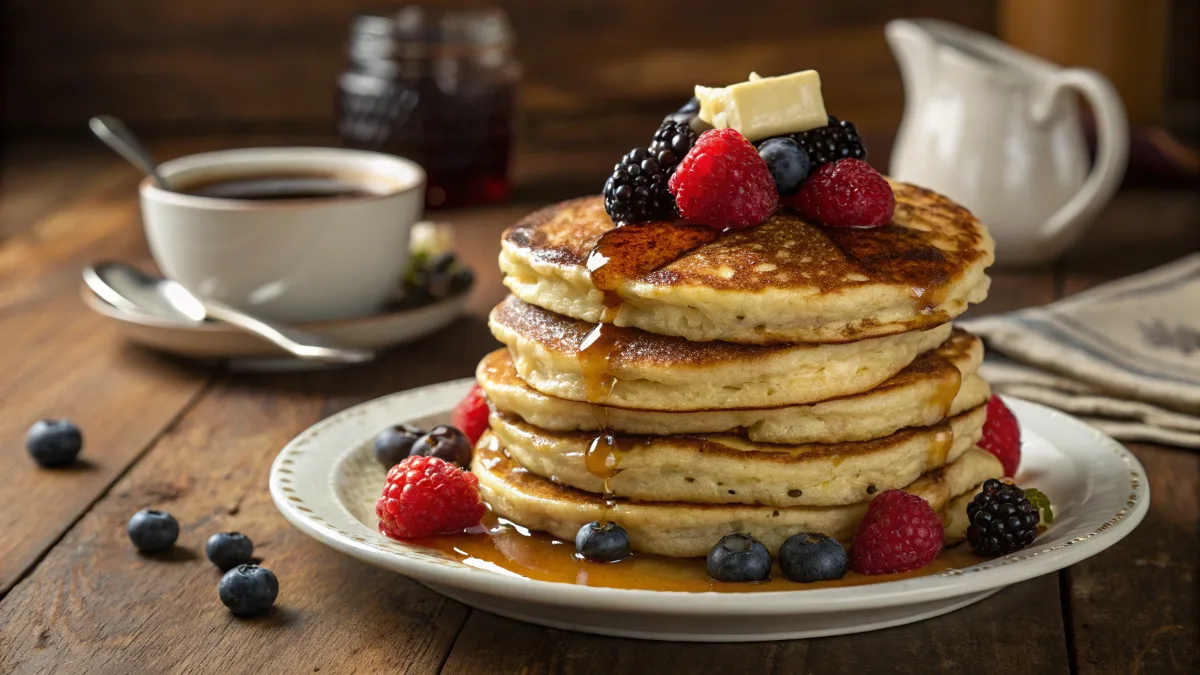Sourdough breakfast recipes are a delicious and nutritious way to start your day. The natural fermentation process in sourdough enhances flavor while making it easier to digest, offering a wholesome alternative to traditional breakfast options. Whether you prefer fluffy pancakes, crispy waffles, or hearty toast, sourdough can elevate your morning meal with its distinct tang and airy texture.
One of the most popular sourdough breakfast recipes is pancakes—light, flavorful, and packed with gut-friendly benefits. By using a well-maintained sourdough starter, you can create pancakes that are not only soft and tender but also healthier than conventional ones. In this guide, we’ll explore how to make the perfect sourdough pancakes, along with essential tips for achieving the best results.
Why Choose Sourdough for Breakfast?
Sourdough breakfast recipes have been a staple in baking for centuries, making a strong comeback in modern kitchens., especially for breakfast. More people are discovering that sourdough is not only flavorful but also easier to digest and packed with health benefits. Whether you’re making pancakes, waffles, or toast, incorporating sourdough breakfast recipes into your morning routine can be a game-changer.
Benefits of Sourdough Fermentation
The fermentation process in sourdough breakfast recipes allows wild yeast and lactic acid bacteria to break down the flour, enhancing nutrition and flavor., creating a unique flavor and texture. Unlike conventional bread, which uses commercial yeast, sourdough relies on a slow fermentation process, which enhances its nutritional profile.
| Benefit | How It Works |
|---|---|
| Improved Digestion | The fermentation process breaks down gluten, making it easier to digest for those with sensitivities. |
| Better Nutrient Absorption | Phytic acid, which can block mineral absorption, is reduced, allowing your body to absorb more iron, zinc, and magnesium. |
| Lower Glycemic Index | Sourdough bread and pancakes cause a slower rise in blood sugar, making them a better option for those managing glucose levels. |
| Rich in Probiotics | Lactic acid bacteria contribute to gut health, supporting digestion and immune function. |
Is Sourdough Healthier Than Regular Bread?
Many people wonder whether sourdough is actually a better choice compared to store-bought bread or conventional pancake mixes. The answer lies in its fermentation. Unlike processed white bread, sourdough retains more nutrients and has a lower glycemic impact. Additionally, it avoids the additives and preservatives found in many commercial breads.
Sourdough pancakes, in particular, can be a fantastic breakfast choice since they retain these health benefits while offering a naturally tangy and rich flavor. By choosing sourdough over regular batter, you’re not just making a delicious meal—you’re making a healthier one.
Nutritional Advantages of Sourdough Breakfast Recipes
Sourdough breakfast recipes provide a balanced mix of carbohydrates, fiber, and protein, helping to keep you full and energized throughout the morning. Here’s a look at the nutrients found in a standard sourdough pancake serving:
| Nutrient | Amount per Serving (2 Pancakes) | Benefits |
|---|---|---|
| Carbohydrates | 30g | Provides sustained energy |
| Protein | 6g | Supports muscle repair and growth |
| Fiber | 2g | Aids digestion and keeps you full longer |
| Iron | 10% DV | Supports red blood cell production |
| Probiotics | Varies | Promotes gut health |
Essential Ingredients for Sourdough Pancakes
Making sourdough pancakes requires just a few key ingredients, but understanding their role can help you achieve the perfect texture and flavor.
Sourdough Starter: Active vs. Discard
The sourdough starter is the heart of any sourdough recipe. There are two main ways to use it:
- Active Starter – This is a bubbly, fed starter that provides the most rise and fluffiness. It requires feeding before use and takes longer to ferment.
- Discard Starter – This is unfed and slightly weaker, but it still adds great flavor. It’s perfect for recipes where rise isn’t a priority, such as pancakes.
Using discard starter in sourdough breakfast recipes gives them a mild tang without the extended fermentation time, and there are many creative ways to use it in sourdough discard breakfast recipes..
Choosing the Right Flour for Sourdough Pancakes
Choosing the right flour is crucial when making sourdough breakfast recipes like pancakes. Here are some great choices:
| Type of Flour | Texture Result | Best For |
|---|---|---|
| All-Purpose Flour | Light and fluffy | Classic pancakes |
| Whole Wheat Flour | Hearty and slightly dense | Higher fiber content |
| Spelt Flour | Mildly nutty and soft | Easier digestion |
| Buckwheat Flour | Rich and nutty | Gluten-free alternative |
Eggs, Milk, and Natural Sweeteners for Better Texture
The remaining ingredients contribute to structure, moisture, and taste:
- Eggs – Provide structure and richness.
- Milk – Helps create a smooth batter and balances tanginess. Dairy or plant-based options both work.
- Natural Sweeteners – Honey, maple syrup, or coconut sugar add a touch of sweetness without overpowering the sourdough flavor.
Step-by-Step Guide to Making the Perfect Sourdough Pancakes
Preparing the Batter for Fluffy Pancakes
The secret to soft, airy pancakes in sourdough breakfast recipes is a well-mixed batter with just the right consistency. Here’s a simple breakdown:
- Combine Ingredients – Mix 1 cup of sourdough starter (active or discard), 1 cup of flour, and ½ cup of milk.
- Add Sweetener and Fat – Stir in 1 tbsp of honey and 1 tbsp of melted butter or oil.
- Incorporate Eggs and Leavening – Beat in 1 egg and 1 tsp of baking soda for lift.
- Let It Rest – Allow the batter to sit for 10-15 minutes for optimal hydration.
Resting and Fermentation Time for the Best Results
In sourdough breakfast recipes, fermentation time significantly affects the final texture. If using an active starter, letting the batter rest for 1-2 hours can enhance flavor and rise. For discard starter, a shorter resting time (10-15 minutes) is sufficient.
Cooking Techniques for Golden-Brown Pancakes
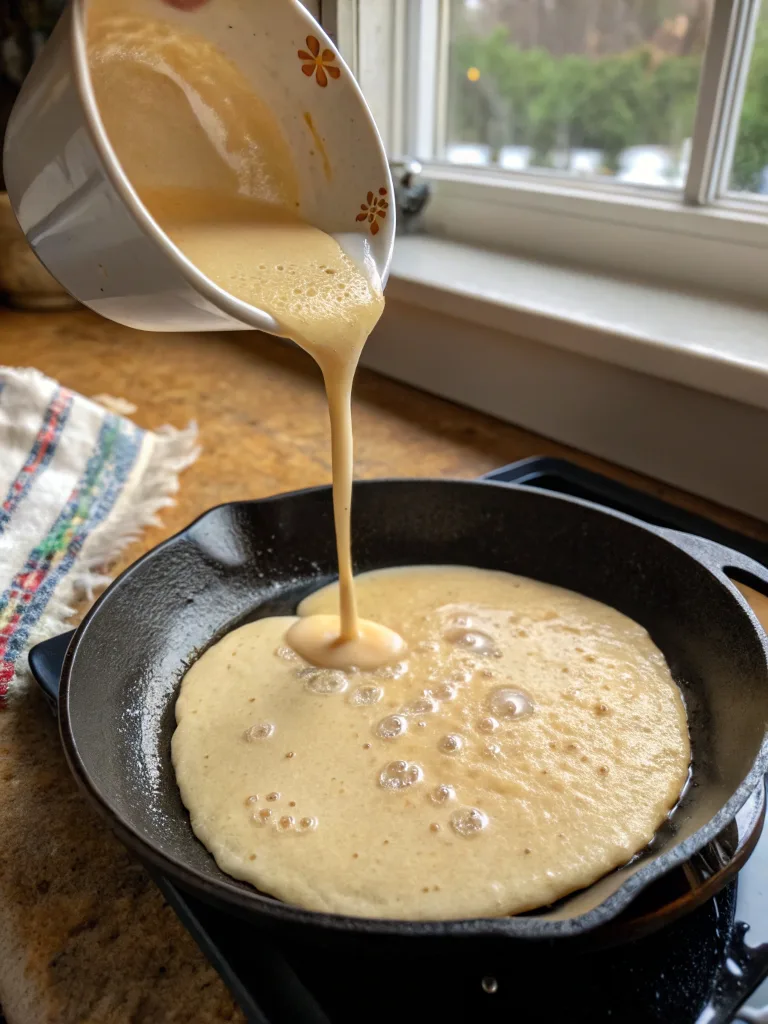
Cooking techniques play a key role in perfecting sourdough breakfast recipes like golden-brown pancakes:
- Use a well-heated griddle – Medium heat prevents burning while ensuring even cooking.
- Grease lightly – Use butter or coconut oil for a non-stick surface.
- Flip at the right time – When bubbles form and edges look set, flip carefully to cook the other side.
Best Toppings and Serving Ideas for Sourdough Pancakes
What Can I Put on Sourdough Pancakes for Breakfast?
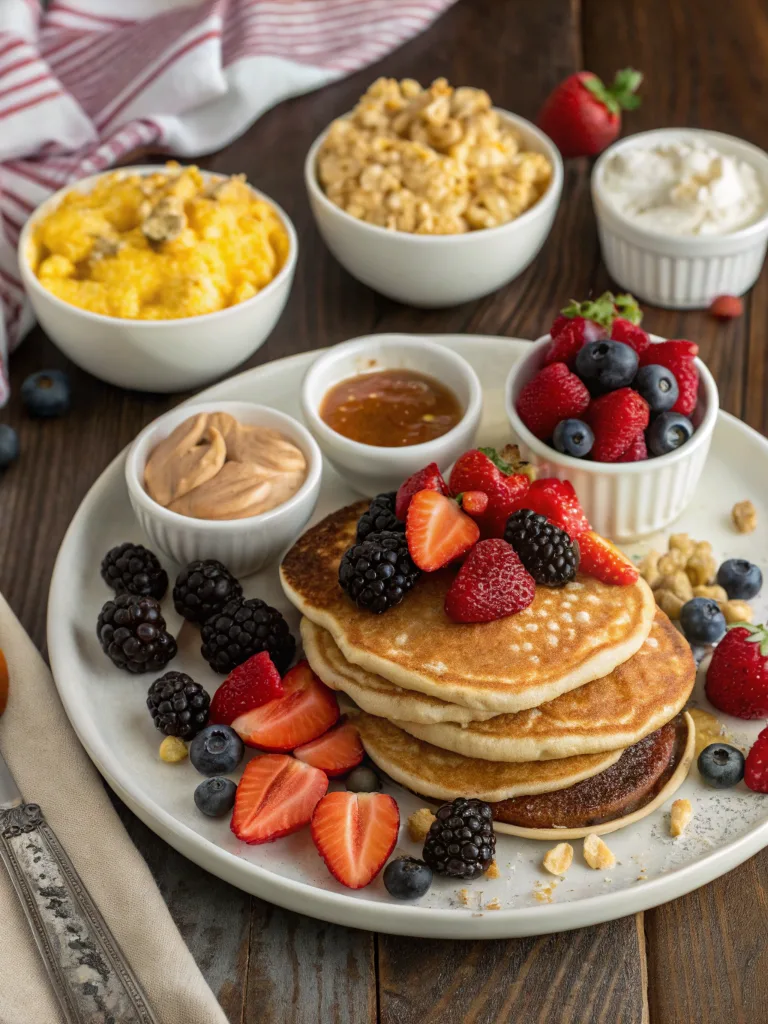
Toppings can transform simple sourdough breakfast recipes into a gourmet meal. Some great options include:
| Type | Toppings |
|---|---|
| Classic | Maple syrup, butter, powdered sugar |
| Healthy | Greek yogurt, fresh fruit, nuts |
| Indulgent | Chocolate chips, whipped cream, caramel drizzle |
Healthy vs. Indulgent Toppings
If you’re aiming for a balanced meal, consider protein-rich toppings like nut butter or Greek yogurt in your sourdough breakfast recipes. For a treat, dark chocolate shavings or homemade berry compote can add sweetness without processed sugars.
Pairing Sourdough Pancakes with Protein-Rich Sides
Pairing sourdough pancakes with protein-rich sides like scrambled eggs, turkey bacon, or a hearty venison breakfast sausage can make them even more filling.
Also, to make your meal more filling, consider adding:
- Scrambled eggs
- Turkey bacon
- Avocado slices
Common Mistakes When Making Sourdough Pancakes
What is the Biggest Mistake You Can Make with Your Sourdough Starter?
One of the most common errors is using an unfed, inactive starter when aiming for fluffy pancakes. An active starter ensures better rise, while discard is best for flatter pancakes.
Why Pancakes Turn Out Too Dense or Sour
- Too much starter – Can lead to an overly tangy flavor.
- Over-mixing the batter – If your sourdough breakfast recipes, especially pancakes, turn out too dense, the batter may have been overmixed.
- Skipping the resting time – In sourdough breakfast recipes, skipping the resting time causes less rise and uneven texture.
How to Fix Common Texture and Flavor Issues
| Issue | Solution |
|---|---|
| Too Dense | Add baking soda or let batter rest longer |
| Too Sour | Reduce fermentation time or use a fresher starter |
| Not Fluffy | Ensure proper hydration and don’t over-mix |
Understanding how to balance the ingredients will improve the final texture of your sourdough breakfast recipes.
Using Sourdough Starter Effectively
A well-maintained sourdough starter is essential for achieving the best flavor and texture in sourdough breakfast recipes like pancakes. Understanding how to use, store, and feed your starter can make all the difference in your breakfast recipes.
Do You Discard Starter Every Time You Feed It?
Yes, discarding a portion of your sourdough starter before feeding is necessary for maintaining its balance. If you don’t discard, the starter can become too acidic, affecting its ability to rise and altering the taste of your pancakes. However, instead of throwing it away, you can repurpose sourdough discard in various breakfast recipes.
| Common Uses for Sourdough Discard | Examples |
|---|---|
| Breakfast Items | Pancakes, waffles, muffins |
| Savory Snacks | Crackers, flatbreads, pizza dough |
| Desserts | Brownies, banana bread, cookies |
To maintain a healthy starter, discard half and feed it with equal parts flour and water. If you bake frequently, you can skip discarding by using the starter regularly.
How Much Sourdough Starter to Use for 500g Flour?
The amount of sourdough starter used depends on fermentation time and the desired sourness. A good rule of thumb is:
| Starter Amount | Fermentation Time | Flavor Profile |
|---|---|---|
| 50g starter | 12-24 hours | Mild tang, slow rise |
| 100g starter | 8-12 hours | Balanced flavor, moderate rise |
| 200g starter | 4-6 hours | Strong tang, quick fermentation |
For pancakes and other sourdough breakfast recipes, using 100g of starter per 500g of flour typically yields the best texture —fluffy but not overly sour. If using discard, fermentation time is shorter since the leavening power is reduced.
How to Store and Maintain Your Starter for Breakfast Recipes
If you bake daily, keep your starter at room temperature and feed it once or twice a day. For occasional use, refrigerate it and feed it weekly. When ready to bake, bring it to room temperature and feed it a few hours before mixing your batter.
If you don’t want to waste excess sourdough starter, there are plenty of delicious ways to use it. Many sourdough discard breakfast recipes allow you to make pancakes, waffles, and muffins with minimal effort
Other Sourdough Breakfast Recipes to Try
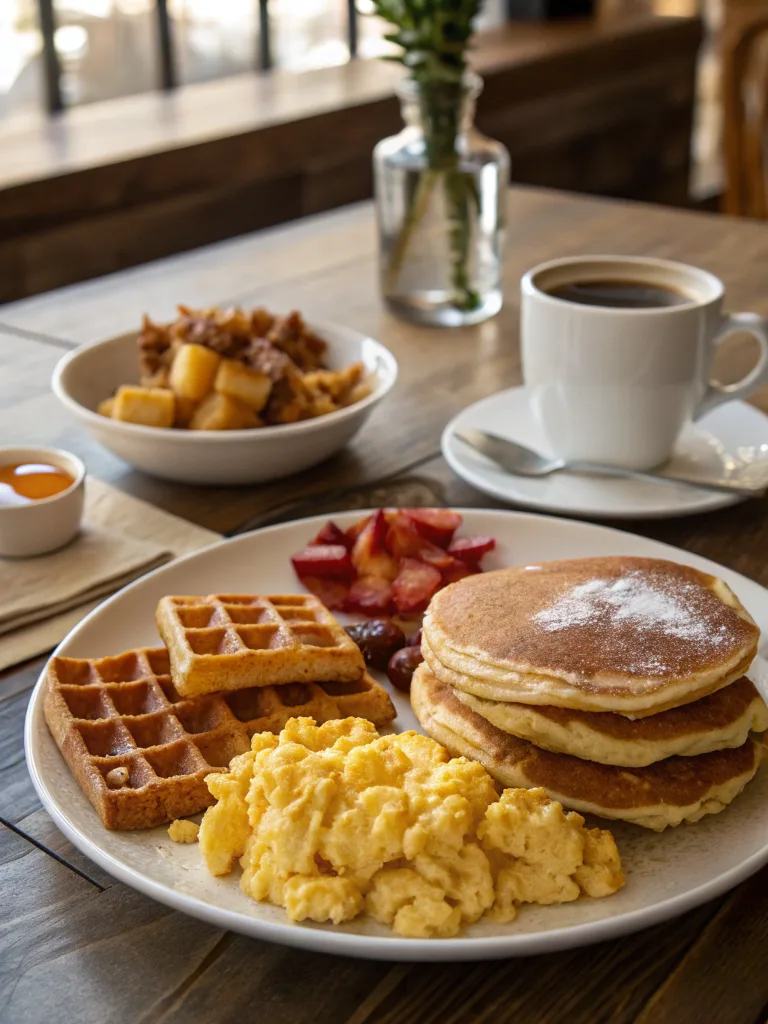
Sourdough isn’t just for pancakes! There are many other delicious ways to incorporate sourdough into your breakfast routine.
Sourdough Waffles: Crispier Than Pancakes
Among sourdough breakfast recipes, waffles offer the same tangy flavor as pancakes but with a crispier exterior. The key difference is the higher fat content and resting time, which allows for better texture.
| Key Differences | Sourdough Pancakes | Sourdough Waffles |
|---|---|---|
| Texture | Soft and fluffy | Crispy on the outside, soft inside |
| Batter Thickness | Thicker, pourable | Slightly runnier |
| Cooking Method | Griddle or pan | Waffle iron |
To make sourdough waffles, simply increase the fat (butter or oil) and let the batter sit for at least 12 hours for enhanced fermentation.
Sourdough Crepes: Thin and Delicate
Crepes are another fantastic option in sourdough breakfast recipes for those who prefer lighter breakfasts. They require more liquid in the batter and a smooth, even spread on the pan. Sourdough crepes pair beautifully with both sweet (berries, honey) and savory (eggs, cheese) fillings.
Sourdough Breakfast Muffins: A Quick Grab-and-Go Option
For busy mornings, sourdough muffins offer a convenient and nutritious solution. Made with sourdough discard, they have a light crumb and a slightly tangy taste. Add nuts, fruits, or chocolate chips for extra flavor.
Breakfast muffins made with sourdough discard are a great addition to your sourdough breakfast recipes collection.
Gluten-Free and Vegan Alternatives for Sourdough Pancakes
For those with dietary restrictions, sourdough breakfast recipes, including pancakes, can still be enjoyed with a few modifications.
Adapting Sourdough Recipes for Dietary Needs
| Diet | Substitutions |
|---|---|
| Gluten-Free | Use oat flour, rice flour, or a gluten-free blend |
| Vegan | Replace eggs with flaxseed or applesauce, use almond milk |
Using Plant-Based Milk and Egg Substitutes
Many non-dairy alternatives work well in sourdough breakfast recipes, especially pancakes. The best options include almond, oat, or coconut milk for a creamy texture. To replace eggs, use:
- Flaxseed Egg – 1 tbsp flaxseed + 3 tbsp water
- Mashed Banana – ¼ cup per egg
- Applesauce – ¼ cup per egg
Best Gluten-Free Flour Options for Sourdough Pancakes
Gluten-free flours react differently to fermentation, so mixing a blend often yields the best results. A good gluten-free mix for sourdough pancakes includes:
| Flour Type | Texture |
|---|---|
| Oat Flour | Soft and mild |
| Rice Flour | Light and crispy |
| Almond Flour | Nutty and dense |
| Tapioca Flour | Adds elasticity |
Adding a binding agent like psyllium husk or xanthan gum helps gluten-free pancakes hold together better.
To make your meal more filling, consider adding a protein-rich side like eggs or a breakfast with sausage recipe for a hearty start to the day.
FAQs About Sourdough Breakfast Recipes
What Can I Put on Sourdough Bread for Breakfast?
Sourdough bread is incredibly versatile and pairs well with both sweet and savory toppings. If you prefer a simple and classic option, spreading butter with a drizzle of honey or jam enhances the naturally tangy flavor of sourdough. Nut butters like almond or peanut butter also complement its texture and add a dose of protein.
For a heartier breakfast, try savory toppings such as avocado with a sprinkle of salt and red pepper flakes. A poached or fried egg on top of sourdough toast makes for a balanced, protein-rich meal. If you’re in the mood for something gourmet, smoked salmon with cream cheese or hummus with sliced tomatoes can elevate your breakfast experience.
How to Eat Sourdough for Breakfast?
There are endless ways to enjoy sourdough breakfast recipes in the morning. You can toast a slice and enjoy it with butter, make an open-faced sandwich, or turn it into a breakfast bruschetta by adding fresh ingredients like tomatoes and basil.
Sourdough also works wonderfully in sourdough French toast, where its dense structure absorbs the custard mixture while maintaining a slight chewiness. If you prefer a quicker option, transform sourdough into croutons and toss them in a yogurt parfait for added crunch. Pancakes, waffles, and muffins made from sourdough starter or discard are also fantastic ways to start the day.
Is Sourdough Actually Healthier Than Regular Bread?
Yes, sourdough is considered healthier than most commercially processed bread. The fermentation process breaks down gluten, making it easier to digest, even for some individuals with mild sensitivities. The natural yeasts and bacteria present in sourdough also help reduce phytic acid, which can inhibit the absorption of minerals like iron and magnesium.
Additionally, sourdough has a lower glycemic index compared to white or whole wheat bread. This means it causes a slower rise in blood sugar levels, making it a more suitable choice for people who need to regulate their glucose intake. The presence of probiotics from the fermentation process can also contribute to gut health, promoting better digestion and nutrient absorption.
What Is the Biggest Mistake You Can Make with Your Sourdough Starter?
One of the most common mistakes is neglecting to feed the starter regularly. A sourdough starter is a living culture that needs consistent care. If it goes too long without feeding, the yeast weakens, leading to poor fermentation and a lack of rise in your baked goods.
Another frequent mistake is using an overly acidic starter. If the starter sits unfed for too long, it can develop an overpowering tang that may negatively impact the flavor of your pancakes or bread. Also, improper storage, such as sealing the starter in an airtight container without airflow, can result in off flavors and even spoilage.
Do You Discard Starter Every Time You Feed It?
Yes, discarding part of the starter before feeding it is essential to maintain its health. If you keep feeding without discarding, the starter can become too acidic and weak, reducing its ability to properly ferment. However, instead of throwing the discard away, you can use it in numerous recipes, such as pancakes, waffles, crackers, and even pizza dough.
If you don’t bake frequently, you can store the starter in the refrigerator and feed it once a week, reducing the need for frequent discards. Some bakers also choose to dehydrate excess starter to preserve it for later use.
How Much Sourdough Starter to Use for 500g Flour?
The ideal amount of sourdough starter depends on the fermentation time and the desired flavor. For a mild tang and moderate rise, 100g of starter per 500g of flour is recommended. If you want a more pronounced sourdough flavor, you can increase the starter to 150g or even 200g. However, using too much starter can speed up fermentation, making the dough harder to control.
For pancakes, where fermentation is less critical than in bread, using around 100g of starter for 500g of flour ensures a balanced taste and texture. If you’re using sourdough discard, it’s best to keep the amount lower, as it has a weaker leavening effect compared to an active starter.
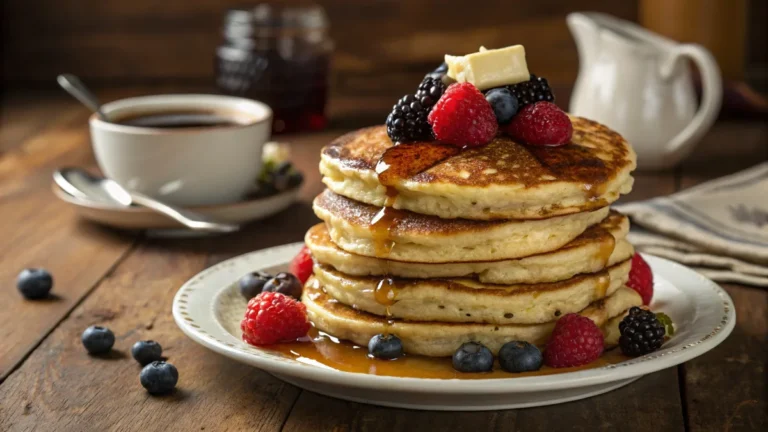
Sourdough Breakfast Recipes: How To Make The Perfect Pancakes
Light, fluffy, and tangy sourdough pancakes made with a fermented starter for a healthy and delicious breakfast.
- Total Time: 25 minutes
- Yield: 4 servings 1x
Ingredients
- 1 cup sourdough starter (active or discard)
- 1 cup all-purpose flour
- 1/2 cup milk (dairy or plant-based)
- 1 tbsp honey or maple syrup
- 1 tbsp melted butter or oil
- 1 egg
- 1 tsp baking soda
- 1/2 tsp salt
Instructions
- In a mixing bowl, combine sourdough starter, flour, and milk. Stir well.
- Add honey, melted butter, and mix until smooth.
- Beat in the egg, then add baking soda and salt.
- Let the batter rest for 10-15 minutes.
- Heat a griddle over medium heat and lightly grease with butter or oil.
- Pour batter onto the griddle, cooking until bubbles form and edges set.
- Flip and cook for another minute until golden brown.
- Serve warm with your favorite toppings.
Notes
For a fluffier texture, let the batter rest longer. Adjust sweetness and toppings to preference.
- Prep Time: 15 minutes
- Cook Time: 10 minutes
- Category: Breakfast
- Method: Griddle
- Cuisine: American
- Diet: Vegetarian
Nutrition
- Serving Size: 2 pancakes
- Calories: 220
- Sugar: 5g
- Sodium: 300mg
- Fat: 8g
- Saturated Fat: 3g
- Unsaturated Fat: 4g
- Trans Fat: 0g
- Carbohydrates: 30g
- Fiber: 2g
- Protein: 6g
- Cholesterol: 55mg
Keywords: sourdough, pancakes, breakfast, healthy, fermented
All nutritional values and baking times are approximate and may vary based on ingredients, equipment, and altitude. Please adjust as needed.
Conclusion
Sourdough breakfast recipes offer a delicious and healthy way to start your day, with pancakes being one of the most popular options. Thanks to the natural fermentation process, sourdough pancakes are easier to digest, have a rich, tangy flavor, and provide essential nutrients that processed breakfast foods often lack. Whether you use an active starter for a fluffy texture or discard for convenience, mastering the right ingredients and techniques ensures perfect pancakes every time.
Beyond pancakes, sourdough can be incorporated into a variety of breakfast dishes, from waffles to crepes and even muffins. With gluten-free and vegan adaptations available, there’s a sourdough breakfast option for everyone. Experiment with different toppings and pairings to create a meal that’s both satisfying and nourishing. Ready to make the switch to sourdough? Start with these simple and delicious recipes!
Table of Contents
Stay Connected for More Sourdough Creations! 🌾🥞
Love experimenting with sourdough breakfast recipes? Follow us for more delicious ideas, expert tips, and exclusive recipes! Connect with us on Facebook, Pinterest, and Twitter to stay inspired.
More sourdough breakfast recipes Inspiration Awaits! 🌟
If you’re eager to try more ways to use your sourdough discard, take a look at this helpful resource for 20 creative breakfast ideas!

